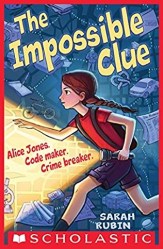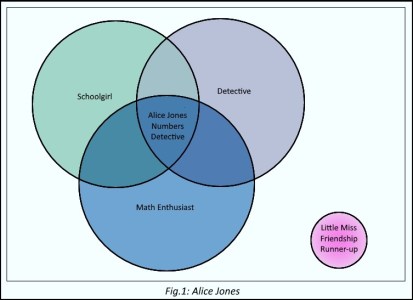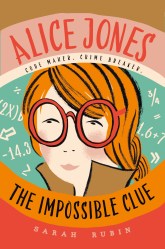Each month I’m picking a topic or a theme for my Tuesday posts, and for November — inspired by my recent discovery of The Three Investigators, Robin Stevens, and the excellent Mystery & Mayhem collection — it’s going to be detective novels for younger readers. I have what I hope will be four very different books lined up, starting with this impossible disappearance.
The setup is classically simple: a man walks into a room with only one exit, which is under constant observation, and when someone else enters the room several hours later he has vanished. How’s that exit observed for several hours? Well, by security camera, of course. And so the only conceivable way out is if he finally perfected the invisibility technology he was working on…wait, what? Cue a number-obsessed twelve year-old girl recently flushed with success from a squirrel-finding case — she wasn’t looking for squirrels, but squirrels is what she found — and you’re ready to go. And, honestly, this whole thing is a lot of fun.
I presume — possibly wrongly — that my readership is comprised primarily of adults blessed with a certain amount of life-won cynicism, all of which makes this focus on literature for little folk something akin to blog suicide now I come to think about it. Oh, well, it’s too late to back out now. See, this book is not written for you; you’ll get the central trick, I’m sure, and possibly not buy fully into the family drama that surrounds it, but that’s not to say you won’t be able to enjoy it. Because it is very, very good, and augurs well for the standard and type of detective fiction currently available to young minds that will prepare them superbly for the sort of joys that lie ahead from the masters of the genre. And seeing someone do that is kind of wonderful.
How do I love thee? Let me count the ways….

Rubin’s tone is note-perfect, particularly in the realisation of the slightly-askew Alice. Nothing is ever explicitly stated, but her obsession with numbers and counting, and the faint reluctance with which she faces the real world outside of Goldbach’s Conjecture, hints at an aspect of autism in her personality that is all the better for never being directly addressed. She’s no genius, she just loves a puzzle and has an insight into rigour that sets her apart:
The problem was, all anyone had seen was the tape of Dr Learner disappearing from a locked room, and they had jumped to conclusions before learning all the facts. It was sloppy, bad logic and it made my skin itch.
There’s perhaps a little too much life-won weariness and adulthood in her to quite ring true — the coffee fixation, using phrases like “what I knew didn’t even amount to a hill of beans” — but the younger, aspirational audience this is aimed at will undoubtedly eat this up. And there are some beautiful turns of phrase (“I could see dreams of insider access coming off my father in concentric rings”) mixed with enough humour to more than win through:
Sammy stood in the doorway wearing a maroon paisley dressing gown with satin lapels. He looked like he’d walked straight out of a Sherlock Holmes novel.
A certain suspension of disbelief may be required to accept the hiring of a 12 year-old to look into the crime, if crime there was, but in fairness this is no more ridiculous than Richard Queen allowing his son to wander into and all over crime scenes, or a lexicographer compiling a magnum opus on drinking customs ending up involved in crime of a peculiarly fiendish complexity. Actually, the in-universe explanation given is pretty good all told, as is the justification used for her father to be more than happy for her to get involved, but, dude, it’s fiction and we try our hardest not to get hung up on these trifles. Do you wanna watch a baffling crime being unpicked, or do you wanna spend 300 pages with 12 year-olds being kept out of everything and sulking about it in their bedrooms?


You’ve not really convinced me about this one, but look forward to your other selections in this category. I hope you were successful in tracking down one of the Ken Holt titles by Bruce Campbell. It would be great to get another take on that series.
LikeLike
As yet, no Bruce Campbell/Ken Holt, no. All in good time, but I have plenty of Three Investigators and others to work through yet. I will say that I’m extremely interested to find out about the book I’m planning on doing in the final week of this…but no more on that for now 🙂
LikeLike
I hadn’t heard of this series before but it sounds interesting. It will be a few years before my daughter is old enough to read these kinds of stories but I am saving a note about these for later!
LikeLike
I’ll be reading the second one at some point mbecause I like many of the aspects of what Rubin provides here — so watch this space.
LikeLiked by 1 person
It’s pleasing to think that today’s youngsters will have a better introduction to detection than my own early starting point of the Five-Find-outers and dog. I doubt any implausibility in this book would outweigh that particular fantasy world (for which I had a mixture of about two parts fondness to three of exasperation). Look forward to your next choices.
LikeLike
Yeah, my launch on detective fiction as a youngling was the relaunched Nancy Drew mysteries from the 1980s…no wonder it took me so long to get back around to “proper” detective fiction (via a lot of late 90s/early 2000s crime writing). There’s definitely a tradition of celebrating the classic detective mould here, and it’s something there appears to be quite a lot of in youngling fiction at present…lucky them!
LikeLike